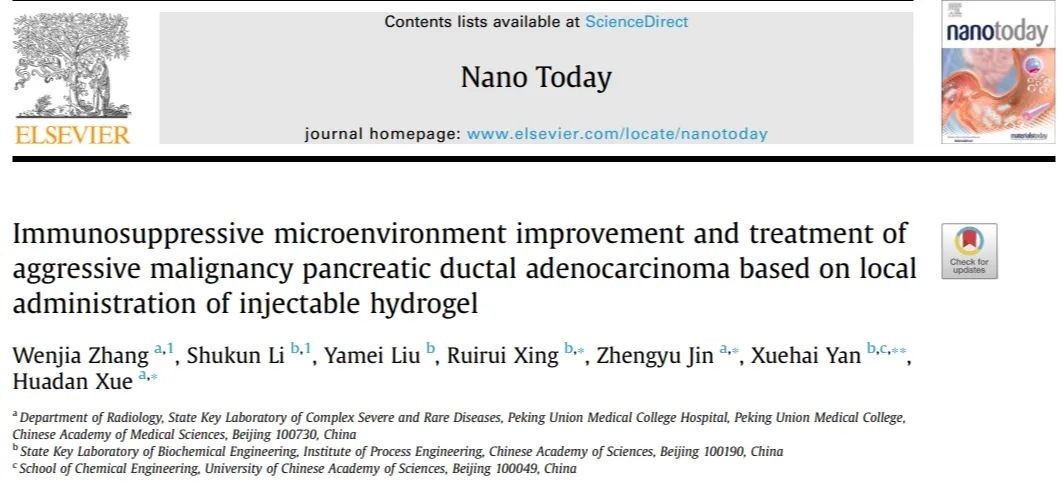Recently, Professor Xue Huadan and Professor Jin Zhengyu from the Department of Radiology at PUMCH, together with the team from the State Key Laboratory of Biochemical Engineering affiliated with the Chinese Academy of Sciences, published their research findings on the treatment of pancreatic cancer using near-infrared photothermal immunotherapy as original investigation in the internationally renowned journal “Nano Today” (a Tier 1 journal, or among the top 5%, as ranked by the Chinese Academy of Sciences, IF: 17.4). The research team developed a new injectable hydrogel specifically designed for the unique tumor microenvironment (TME) of pancreatic cancer. Animal models demonstrated that this novel hydrogel can rapidly induce local photothermal effect to ablate tumor cells, regulate the immune system, and effectively inhibit the progression and metastasis of pancreatic cancer. This research received support from the National High-level Hospital Clinical Research Funding.

Pancreatic cancer is one of the most devastating tumors due to its highly malignant nature and poor prognosis. Studies have shown that the TME of pancreatic cancer is characterized by a profuse fibrotic stromal reaction, a dearth of tumor-infiltrating T immune cells, hypoxia, and strong immunosuppression, which results in limited effectiveness of existing immunotherapies.
In light of the highly immunosuppressive microenvironment, the team developed the synergistic “near-infrared (NIR) photothermal therapy + immunotherapy” (“photothermal immunotherapy” for short) to regulate the TME of pancreatic cancer. This transforms the immunologically unresponsive “cold” pancreatic tumor into “hot” tumor. This study developed an injectable peptide-based hydrogel for integration with near-infrared photothermal pigment (biliverdin, short as BV) and a clinically approved immunomodulatory peptide (thymopentin, TP5). The team employed a dual-modal imaging technique combining magnetic resonance imaging (MRI) and optical imaging to monitor the effectiveness of the combined treatment.
The team first confirmed the photothermal conversion ability of the BV/TP5 hydrogel through in vitro experiments. In an orthotopic pancreatic cancer animal model, the BV/TP5 hydrogel exhibited excellent repeated injectability and biocompatibility due to its shear-thinning and self-healing properties. After intratumoral injection of the BV/TP5 hydrogel followed by photothermal therapy, the tumor temperature increased from 29.2°C to 54.6°C within 10 minutes. Further imaging analysis before and after treatment revealed that the BV/TP5 hydrogel significantly inhibited tumor progression. Pathological results demonstrated that the BV/TP5 hydrogel suppressed the metastasis to other organs such as the liver and spleen from pancreatic cancer.
The team took it further into the mechanism of action of photothermal immunotherapy. In experiments conducted at three different levels, namely tumor-draining lymph node cells, splenic cells, and tumor tissue cells, the BV/TP5 hydrogel significantly enhances the activity of immune cells such as CD4+ and CD8+, effectively inhibits the in situ growth of pancreatic cancer cells, stimulates the generation of immune response, and inhibits distant metastases. Results of hypoxia-related indicators show that BV-mediated photothermal effects effectively alleviated the hypoxic conditions in the TME, making it suitable for synergistic treatment of pancreatic cancer.

▲Structure of the BV/TP5 hydrogel and its application in photothermal immunotherapy
In summary, targeting the highly immunosuppressive TME of pancreatic cancer, the research team has developed a novel injectable BV/TP5 hydrogel. The innovative photothermal immunotherapy can not only ablate the tumor in situ but also systematically activate the immune response, thereby inhibiting distant metastasis and recurrence of the tumor. This therapy exhibits good biocompatibility and safety, providing an innovative strategy for the treatment of pancreatic cancer.
If you are interested, please access the paper at https://www.sciencedirect.com/science/article/pii/S1748013223000816
Written by Zhang Wenjia and Gan Dingzhu
Edited by Gan Dingzhu
Translated by Liu Haiyan
Reviewed by Zhu Liang and Wang Yao
